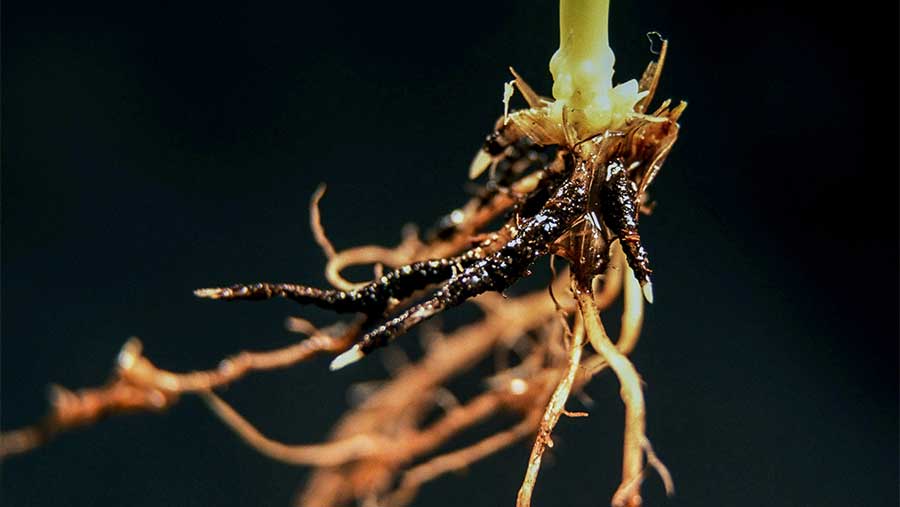Take-all seed treatment benefits winter wheat, reveals trial
 Wheat root blackened with take-all-disease © Blackthorn Arable
Wheat root blackened with take-all-disease © Blackthorn Arable Independent research investigating the effects of a seed treatment to control take-all in winter wheat has yielded a clear benefit for growers in “at risk” situations.
The trial carried out by independent crop consultancy firm Adas tested the Latitude seed dressing, containing the active ingredient silthiofam.
Generating an average yield response of 1.4t/ha and improved returns, growers with a high number of cereals in their rotation may well benefit from the seed treatment to mitigate against take-all’s yield-robbing traits.
See also: Biological brews help grower keep crop disease at bay
Trial results
Chloe Morgan, plant pathologist at Adas, tested four different winter wheat varieties in a fully-replicated trial last year.
Each were treated with both a single-purpose dressing and with the Latitude seed treatment alongside the single-purpose dressing.
At harvest, yield results showed a clear benefit from the Latitude seed treatment across all four varieties, with an average yield response of 1.4t/ha.
When comparing the two seed dressings, Extase yielded 1.9t/ha extra, while Palladium saw a yield uplift of 0.9t/ha.
“The data from last year’s trial showed that where planting second and consecutive wheats, the use of Latitude seed treatment is a useful risk management strategy to protect against yield loss,” says Miss Morgan.
She continues: “The trial showed that picking the right variety can reduce the impact of take-all on the crop, with plant assessments in the single purpose dressing only treatments showing less severe root damage on Palladium than Extase.”
Financial return
Adas have created a Latitude Cost Benefit Calculator which assumes a modest 0.55t/ha response, taken as a medium risk average from many years’ of trials.
The Latitude treatment costs about £230/t, so assuming harvest 2024 wheat futures are at £200/t, and a seed rate of 250kg/ha drilled in mid-October, the online tool reveals just 0.28t/ha is needed to cover treatment cost.
This delivers a respectable margin of £53.75/ha.
Miss Morgan is running a similar trial this year and after first visual assessments in plots, take-all symptoms are not so obvious.
She suspects this is down to infected plants having easier access to water and nutrients, unlike last year when drought exacerbated symptoms, resulting in stunted plants, bleached ears known as “white heads” and early senescence.
“It doesn’t mean take-all isn’t there and it will be building on roots, so we may see signs during later observations in late June or early July.”
What is take-all?
Take-all is a yield-robbing disease caused by the soil-borne pathogen Gaeumannomyces tritici which is commonly found across UK arable soils.
The pathogen can build to concerning levels when a second, third or even fourth cereal is grown.
At its most damaging on light, sandy soils, take-all can cause yield losses of up to 50% in winter wheat.
